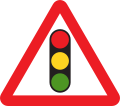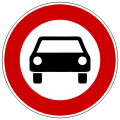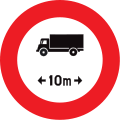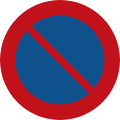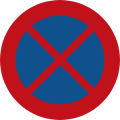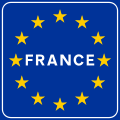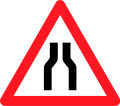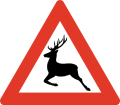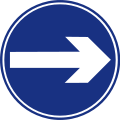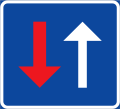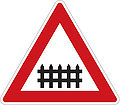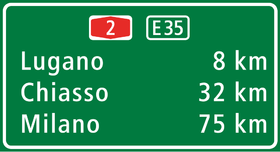
Example of Swiss sign near
Lugano
Despite an apparent uniformity and standardization, European traffic signs presents relevant differences between countries. However most European countries refer to the 1968 Vienna Convention on Road Signs and Signals — adopted in Europe by Albania, Austria, Belarus, Belgium, Bosnia and Herzegovina, Bulgaria, Croatia, Czech Republic, Denmark, Estonia, Finland, France, Germany, Greece, Hungary, Italy, Latvia, Lithuania, Luxembourg, Macedonia, Montenegro, Norway, Poland, Romania, Russia, San Marino, Serbia, Slovakia, Sweden, Switzerland and Ukraine.
(To view this article correctly, make sure you have a high screen resolution. Otherwise, zoom out your web browser).
|
Contents
- 1 Differences between European traffic signs
- 2 Table of traffic signs comparison
- 2.1 Germany, France, UK, Italy, Spain, Netherlands, Belgium
- 2.2 Switzerland, Austria, Ireland, Poland, Sweden, Finland, Norway
- 2.3 Greece, Czech Republic
- 3 Notes
- 4 See also
- 5 References
- 6 External links
|
Differences between European traffic signs
Main differences are related to
- graphic differences
- differences in meanings
- the use of a different colour-code scheme
- local language texts (sometimes bilingual)
Graphic differences
- Warning signs in the Republic of Ireland have a diamond shape with a yellow background in place of the standard triangular shape. They diverge from the standards of the rest of Europe.
- Many pictograms (tunnel, pedestrian, car, etc.) are quite different in many countries.
- Type of arrows may be different.
- Fonts of written words
Different typefaces in texts
These are incomplete. You can help by adding missing countries or fonts.
- France uses the Caractères font.
- Austria, Bosnia-Herzegovina, Croatia, Germany, Kosovo, Macedonia, Serbia and Slovenia uses the DIN 1451 font.
- Poland uses the Drogowskaz font.
- Denmark uses the Dansk Vejtavleskrift font.
- Netherlands, Spain and Turkey uses the FHWA font.
- Switzerland uses the Frutiger font.
- Norway uses the Trafikkalfabetet font.
- Greece, Iceland, Ireland, Italy, Portugal and the United Kingdom uses the Transport font.
- Sweden uses the Tratex font.
- Slovakia uses the Universal Grotesk font.
- Estonia uses the Arial Narrow Bold in mixture with Helvetica font.
Different colour codes
Road works/construction
- White texts on a blue background is used in United Kingdom, Germany, France, Spain, Netherlands, Belgium, Ireland, Austria, Luxembourg, Poland, Portugal, Latvia and Hungary.
- White texts on a green background is used in Italy, Switzerland, Denmark, Sweden, Finland, Slovenia, Croatia, Czech Republic, Greece, Cyprus, Romania, Slovakia, and Serbia.
- White-on-blue(in this case the same as motorways [for most countries, not all]) is used in Belgium, Italy, Switzerland, Sweden, Czech Republic, Greece, Cyprus, Slovakia, Romania, Latvia, Finland and Netherlands.
- White-on-green is used in France, Hungary, United Kingdom, Republic of Ireland, Poland and Portugal.
- Black-on-yellow is used in Germany, Luxembourg, Norway, Slovenia, Serbia and Croatia.
- Red-on-white is used in Denmark (though white-on-blue on motorway exits and all overhead gantries)
- Black-on-white is used in Austria and Spain.
Secondary roads
Differences in meanings
- Sometimes similar signs have little differences in meanings, following the local traffic codes.[citation needed]
- European countries use the metric system (distances in kilometres or metres, speeds in kilometres per hour, heights/widths in metres) with the exception of the United Kingdom, where distances, speeds (miles per hour), heights/widths are still indicated in imperial measurements (miles, yards, feet, and inches).
Table of traffic signs comparison
Germany, France, UK, Italy, Spain, Netherlands, Belgium
Comparison of traffic signs in seven countries of Europe (Germany, France, United Kingdom, Italy, Spain, Netherlands and Belgium).
-
-
-
-
-
-
-
-
-
-
-
Fermarsi e dare precedenza
-
-
-
-
-
-
Give way to traffic on major road (yield)
-
-
-
-
Voorrang van kruispunt/Cedez le passage
-
-
Indication de caractère prioritaire
-
-
-
-
-
Voorrangsweg/Indication de caractère prioritaire
-
-
Fin de caractère prioritaire
-
-
Fine del diritto di precedenza
-
-
-
Einde voorrangsweg/Fin de caractère prioritaire
-
-
Panneau temporaire de signalisation de danger
-
-
-
-
-
Gevaar/Panneau temporaire de signalisation de danger
-
-
Circulation dans les deux sens
-
Two-way traffic straight ahead
-
Doppio senso di circolazione
-
Circulación en los dos sentidos
-
-
Inrijden toegestaan/Circulation dans les deux sens
-
-
-
Traffic queues likely ahead
-
-
-
-
-
-
-
-
-
-
-
Verkeerslichten/Feux tricolores
-
Bahnübergang ohne Schranken
-
Passage à niveau sans barrière
-
Railway level crossing without gate or barrier ahead
-
Passaggio a livello senza barriere
-
Paso a nivel sin barreras
-
-
Overweg zonder slagbomen/Passage à niveau sans barrière
-
Bahnübergang mit Schranken [nb 1]
-
Passage à niveau muni de barrières
-
Level crossing with barrier or gate ahead
-
Passaggio a livello con barriere
-
Paso a nivel con barreras
-
-
Overweg met slagbomen/Passage à niveau muni de barrières
-
Kreuzung mit Vorfahrt von rechts
-
-
Crossroads with right-of-way from the right
-
Intersezione con precedenza a destra
-
Intersección con prioridad de la derecha
-
-
Gevaarlijk kruispunt/Priorité à droite
-
-
-
Crossroads (junction with a minor cross road)
-
Intersezione con diritto di precedenza
-
Intersección con prioridad
-
-
Voorrangskruispunt/Priorité ponctuelle
-
-
-
Road narrows on both sides
-
-
Estrechamiento de calzada
-
-
Rijbaanversmalling/Chaussée rétrécie
-
Einseitig (rechts) verengte Fahrbahn
-
Chaussée rétrécie par la droite
-
-
Strettoia asimmetrica a destra
-
Estrechamiento de calzada por la derecha
-
Rijbaanversmalling rechts
-
Rijbaanversmalling rechts/Chaussée rétrécie par la droite
-
-
-
-
-
-
-
-
-
-
Steep hill downwards (10%)
-
-
Bajada con fuerte pendiente
-
-
Steile heiling/Descente dangereuse
-
-
-
-
-
Curva peligrosa hacia la derecha
-
-
Bocht naar rechts/Virage à droite
-
-
-
Double bend, first to left
-
Doppia curva, la prima a sinistra
-
Curvas peligrosas hacia la izquierda
-
Bocht(en), eerst naar links
-
Bocht(en), eerst naar links/Succession de virages
-
-
-
-
-
-
-
Slipgevaar/Chaussée glissante
-
-
-
-
-
-
-
-
-
Risque de chutes de pierres
-
-
-
-
-
Vallende stenen/Risque de chutes de pierres
-
-
-
Opening or swing bridge ahead
-
-
-
-
Beweegbare brug/Pont mobile
-
-
Débouché sur un quai ou une berge
-
-
Sbocco su molo o su argine
-
-
-
Kade/Débouché sur un quai ou une berge
-
-
Passage d’animaux sauvages
-
-
Animali selvatici vaganti
-
Paso de animales en libertad
-
-
Groot wild/Passage d’animaux sauvages
-
-
-
No entry for vehicular traffic
-
-
-
Gesloten in deze richting
-
Gesloten in deze richting/Interdit
-
Verbot für Kraftwagen und sonstige mehrspurige Kraftfahrzeuge
-
Accès interdit à tous les véhicules à moteur
-
No motor vehicles except solo motor cycles
-
Transito vietato a tutti gli autoveicoli
-
Entrada prohibida a vehículos de motor, excepto motocicletas de dos ruedas
-
Gesloten voor alle motorvoertuigen
-
Gesloten voor motorvoertuigen met meer dan twee wielen en motorfietsen met zijspan/Accès interdit à tous les véhicules à moteur
-
Verbot für Krafträder, auch mit Beiwagen, Kleinkrafträder und Mofas
-
Accès interdit aux motocyclettes et motocyclettes légères
-
-
Transito vietato ai motoveicoli
-
Entrada prohibida a motocicletas
-
Gesloten voor motorfietsen
-
Gesloten voor motorfietsen/Accès interdit aux motocyclettes et motocyclettes légères
-
-
Accès interdit aux cycles
-
-
Transito vietato alle biciclette
-
Entrada prohibida a bicicletas
-
-
Gesloten voor fietsen/Accès interdit aux cycles
-
Verbot für Kraftfahrzeuge mit einem zulässigen Gesamtgewicht über 3,5 t, einschließlich ihrer Anhänger und Zugmaschinen, ausgenommen Personenkraftwagen und Kraftomnibusse
-
Accès interdit aux véhicules affectés au transport de marchandises
-
-
Transito vietato ai veicoli di massa a pieno carico superiore a 3,5 t
-
Entrada prohibida a vehículos destinados al transporte de mercancías de tipo camión o furgoneta
-
Verboden voor voertuigen die een hogere aslast hebben dan 4,8 t
-
Verboden voor voertuigen die een hogere aslast hebben dan gezecht/Accès interdit aux véhicules affectés au transport de marchandises
-
Dem Gegenverkehr Vorfahrt gewähren
-
Cédez le passage à la circulation venant en sens inverse
-
Give priority to vehicles from opposite direction
-
Dare precedenza nei sensi unici alternati
-
Prioridad al sentido contrario
-
-
Voorrang verlenen/Cédez le passage à la circulation venant en sens inverse
-
-
Interdiction de dépasser tous les véhicules à moteur autres que ceux à deux roues sans side-car
-
-
-
-
-
Inhalen verboden/Interdiction de dépasser tous les véhicules à moteur autres que ceux à deux roues sans side-car
-
Zulässige Höchstgeschwindigkeit (60 km/h)
-
Limite de vitesse (50 km/h)
-
-
Limite massimo di velocità (50 km/h)
-
Velocidad máxima (100 km/h)
-
Maximumsnelheid (50 km/h)
-
Maximumsnelheid/Limite de vitesse (60 km/h)
-
-
Accès interdit aux véhicules dont la hauteur, chargement compris, est supérieure au nombre indiqué
-
No vehicles over height shown
-
Transito vietato ai veicoli aventi altezza superiore
-
Prohibido el paso a vehículos superiores a la altura máxima indicada
-
Gesloten voor voertuigen die hoger zijn dan gezecht
-
Gesloten voor voertuigen die hoger zijn dan gezecht/Accès interdit aux véhicules dont la hauteur, chargement compris, est supérieure au nombre indiqué
-
-
Accès interdit aux véhicules dont la longueur est supérieure au nombre indiqué
-
No vehicles over length shown
-
Transito vietato ai veicoli aventi larghezza superiore
-
-
Gesloten voor voertuigen die langer zijn dan gezecht
-
Gesloten voor voertuigen die langer zijn dan gezecht/Accès interdit aux véhicules dont la longueur est supérieure au nombre indiqué
-
Verbot für kennzeichnungspflichtige Kraftfahrzeuge mit gefährlichen Gütern
-
Accès interdit aux véhicules transportant des marchandises dangereuses
-
Vehicles carrying dangerous goods prohibited (non-prescribed by TSRGD, requiring special authorisation by DfT)
-
Transito vietato ai veicoli che trasportano merci pericolose
-
Entrada prohibida a vehículos que transporten mercancías peligrosas
-
Gesloten voor voertuigen die gevaarklijke stoffen vervoerd
-
Gesloten voor voertuigen die gevaarklijke stoffen vervoerd/Accès interdit aux véhicules transportant des marchandises dangereuses
-
-
Interdiction de faire demi-tour sur la route suivie jusqu’à la prochaine intersection
-
-
-
-
-
Keerverbod/Interdiction de faire demi-tour sur la route suivie jusqu’à la prochaine intersection
-
Eingeschränktes Haltverbot
-
-
-
-
Estacionamiento prohibido
-
-
Parkeerverbod/Stationnement interdit
-
-
Arrêt et stationnement interdits
-
-
-
Parada y estacionamiento prohibidos
-
-
Verboden stil te staan/Arrêt et stationnement interdits
-
Verbot für Fahrzeuge mit wassergefährdender Ladung
-
Accès interdit aux véhicules transportant des marchandises susceptibles de polluer les eaux
-
No vehicles carrying goods which could pollute water
-
Divieto di transito ai veicoli che trasportano prodotti suscettibili di contaminare l'acqua
-
Entrada prohibida a vehículos que transporten productos contaminantes del agua
-
-
Geen voertuigen die goederen vervoerd die het water kan vervuilen
-
Geen voertuigen die goederen vervoerd die het water kan vervuilen/Accès interdit aux véhicules transportant des marchandises susceptibles de polluer les eaux
-
-
-
-
-
-
-
-
Ende sämtlicher Streckenverbote
-
Fin de toutes les interdictions précédemment signalées, imposées aux véhicules en mouvement
-
Derestriction, national speed limit applies
-
-
Fin de restricciones impuestas
-
-
Einde verbod/Fin de toutes les interdictions précédemment signalées, imposées aux véhicules en mouvement
-
Vorgeschriebene Fahrtrichtung - hier rechts
-
Obligation de tourner à droite avant le panneau
-
-
Direzione obbligatoria a destra
-
-
-
Alleen links afslaan/Obligation de tourner à gauche avant le panneau
-
Vorgeschriebene Fahrtrichtung - rechts
-
Direction obligatoire à la prochaine intersection : à droite
-
-
Preavviso di direzione obbligatoria a destra
-
-
Alleen rechts afslaan voren
-
Direction obligatoire à la prochaine intersection: à gauche/Alleen links afslaan voren
-
Vorgeschriebene Fahrtrichtung - rechts vorbei!
-
Contournement obligatoire par la droite
-
-
Passaggio obbligatorio a destra
-
-
-
Rechts passeren/Contournement obligatoire par la droite
-
-
-
Mini-roundabout (roudabout circulation: give way to vehicles from the immediate right)
-
-
-
-
-
Vorrang vor dem Gegenverkehr
-
Priorité avec le passage à la circulation venant en sens inverse
-
Traffic has priority over oncoming vehicles
-
Diritto di precedenza nei sensi unici alternati
-
Prioridad respecto al sentido contrario
-
Voorrang verlenen van tegenmoetkomende verkeer
-
Voorrang verlenen van tegenmoetkomende verkeer/Priorité avec le passage à la circulation venant en sens inverse
-
-
-
Pedestrian/Zebra crossing
-
-
Situación de un paso para peatones
-
-
-
-
-
-
-
-
-
-
Beginn eines verkehrsberuhigten Bereichs
-
Entrée d’une zone de rencontre
-
Start of a designated home zone
-
-
-
-
Erf/Entrée d’une zone de rencontre
-
-
-
-
-
-
-
Tunnel/Entrée d’un tunnel
-
-
-
-
-
-
-
-
-
Route à chaussées séparées
-
-
Strada riservata ai veicoli a motore
-
-
-
Autoweg/Route à chaussées séparées
-
-
-
-
-
-
-
-
-
-
-
-
-
Switzerland, Austria, Ireland, Poland, Sweden, Finland, Norway
Comparison of traffic signs in seven further countries of Europe (Switzerland, Austria, Ireland, Poland, Sweden, Finland and Norway).
-
-
-
-
-
-
-
-
Halt! Vorfahrt gewähren/Arrêt/Fermarsi e dare precedenza
-
-
-
-
-
-
-
Vorfahrt gewähren/Cedez le passage/Dare precedenza
-
-
-
Ustąp pierwszeństwa przejazdu
-
-
-
-
Vorfahrtstrasse/Indication de caractère prioritaire/Diritto di precedenza
-
-
-
-
-
Ensisijaiset tie/Huvudled
-
-
Ende der Vorfahrtstraße/Fin de caractère prioritaire/Fine del diritto di precedenza
-
-
-
Koniec drogi z pierwszeństwem
-
-
Loppu ensisijaisesti tien/Huvudled upphör
-
-
Gefahrstelle/Panneau temporaire de signalisation de danger/Altri pericoli
-
-
-
-
-
-
-
Gegenverkehr/Circulation dans les deux sens/Doppio senso di circolazione
-
-
Two way traffic/Trácht dhá threo
-
Odcinek jezdni o ruchu dwukierunkowym
-
-
Kaksisuuntainen liikenne/Mötande trafik
-
-
-
-
Queues likely/Scuainí dóchúil
-
-
-
Jonotuksen liikenne/Köer sannolikt
-
-
Lichtzeichenanlage/Feux tricolores/Semaforo
-
-
Traffic lights ahead/Comharthaí tráchta romhat
-
-
-
Liikennevalojen/Trafiksignal
-
-
Bahnübergang ohne Schranken/Passage à niveau sans barrière/Passaggio a livello senza barriere
-
Bahnübergang ohne Schranken
-
Unguarded level crossing/Crosaire comhréidh romhat, neamhchosanta ag geataí nó bacainn ardaitheach
-
Przejazd kolejowy bez zapór
-
-
Tasoristeys ilman portit/Plankorsning utan bommar
-
-
Bahnübergang mit Schranken/Passage à niveau muni de barrières/Passaggio a livello con barriere
-
Bahnübergang mit Schranken
-
Level crossing with barrier/Crosaire comhréidh romhat, cosanta ag geataí nó bacainní ardaitheach
-
Przejazd kolejowy z zaporami
-
-
Tasoristeys kanssa portit/Plankorsning med bommar
-
-
Kreuzung mit Vorfahrt von rechts/Priorité à droite/Intersezione con precedenza a destra
-
Kreuzung mit Vorfahrt von rechts
-
-
Niebezpieczne skrzyżowanie z drogą równorzędną
-
-
Leikkaa yhtä tiet (väistyä tulevien ajoneuvojen oikealta)/Korsning
-
-
Vorfahrt/Priorité ponctuelle/Intersezione con diritto di precedenza
-
-
Crossroads with minor road/Crosbhóithre le mionbhóthar
-
Niebezpieczne skrzyżowanie z drogą podporządkowaną po obu stronach
-
Korsning med en väg där användarna har väjningsplikt
-
Risteykseen tien käyttäjät, jotka on väistettävä, 90 ° vasemmalle, 90 ° oikealle/Korsning med en väg där användarna har väjningsplikt
-
-
Verengte Fahrbahn/Chaussée rétrécie/Strettoria simmetrica
-
-
Road narrows on both sides/Cúngaíonn an bóthar ar an dá thaobh
-
-
Vägen smalnar av på båda sidor
-
Tie kapenee molemmin puolin/Vägen smalnar av på båda sidor
-
Smalere veg (begge sider)
-
Einseitig (rechts) verengte Fahrbahn/Chaussée rétrécie par la droite/Strettoia asimmetrica a destra
-
Einseitig (rechts) verengte Fahrbahn
-
Road narrows on right/Cúngaíonn an bóthar ón taobh dheas
-
Zwężenie jezdni z prawej strony
-
Vägen smalnar av från höger sida
-
Tie kapenee oikealle/Vägen smalnar av från höger sida
-
-
Seitenwind/ Vent/Forte vento laterale
-
-
-
-
-
Sivutuuli/Sidvind från höger
-
-
Gefälle/Descente dangereuse/Discesa pericolosa
-
-
Steep decline/Fána ghéar romhat
-
-
-
Jyrkässä mäessä alaspäin/Brant backe nedåt
-
-
Kurve (rechts)/Virage à droite/Curva a destra
-
-
Dangerous left bend/Cor dainséarach romhat
-
Niebezpieczny zakręt w prawo
-
-
Vaarallinen mutka, mutka oikealle/Farlig högerkurva
-
-
Doppelkurve (rechts)/Succession de virages (droite)/Doppia curva, la prima a sinistra
-
-
Dangerous bends/Sraith cúinní dainséarach romhat
-
Niebezpieczne zakręty, pierwszy w lewo
-
Farliga kurvor, första kurvan till vänster
-
Vaaralliset mutkia, ensimmäinen mutka vasemmalle/Farliga kurvor, första kurvan till vänster
-
Farlige svinger (første til venstre)
-
Schleudergefahr/Chaussée glissante/Strada sdrucciolevole
-
-
Slippery road surface/Bóthar sleamhain romhat
-
-
-
Liukkaalla tiellä/Slirig väg
-
-
-
-
Road works/Oibreacha bóthair romhat
-
-
-
-
-
Steinschlag/Risque de chutes de pierres/Caduta massi
-
-
Risk of falling rocks/Dainséar de charraigeacha titime
-
-
Fallande stenar från höger
-
Pudota kiviä/Fallande stenar från höger
-
-
Bewegliche Brücke/Pont mobile/Ponte mobile
-
-
-
-
-
Avaaminen tai kääntösilta/Bro
-
-
Ufer/Débouché sur un quai ou une berge/Sbocco su molo o su argine
-
-
Unprotected quayside/Cé, canáil nó abhainn neamhchosanta romhat
-
-
-
Quayside tai lautta laiturissa/Kaj eller färjeläge
-
Kai, strand eller ferjeleie
-
Wildwechsel/Passage d’animaux sauvages/Animali selvatici vaganti
-
-
Wild animals/Fianna nó ainmhithe fiáine
-
-
-
Eläimet (poro)/Djur (rådjur etc.)
-
-
Verbot der Einfahrt/Interdit/Senso vietato
-
-
No entry/Cosc ar iontráil
-
Zakaz wjazdu wszelkich pojazdów
-
-
Ei merkintä/Förbud mot infart
-
-
Verbot für Kraftwagen und sonstige mehrspurige Kraftfahrzeuge/Accès interdit à tous les véhicules à moteur/Transito vietato a tutti gli autoveicoli
-
Verbot für Kraftwagen und sonstige mehrspurige Kraftfahrzeuge
-
-
Zakaz wjazdu pojazdów silnikowych z wyjątkiem jednośladów
-
-
Ei moottorikäyttöisten ajoneuvojen/Inga motordrivna fordon
-
-
Verbot für Krafträder, auch mit Beiwagen, Kleinkrafträder und Mofas/Accès interdit aux motocyclettes et motocyclettes légères/Transito vietato ai motoveicoli
-
Verbot für Krafträder, auch mit Beiwagen, Kleinkrafträder und Mofas
-
-
-
-
Ei moottoripyörät/Inga motorcyklar
-
Forbudt for motorsykkel og moped
-
Verbot für Radfahrer/Accès interdit aux cycles/Transito vietato alle biciclette
-
-
-
-
Inga cyklar eller mopeder
-
Ei tai mopoja/Inga cyklar eller mopeder
-
-
Verbot für Kraftfahrzeuge mit einem zulässigen Gesamtgewicht über 5,5 t, einschließlich ihrer Anhänger und Zugmaschinen, ausgenommen Personenkraftwagen und Kraftomnibusse/Accès interdit aux véhicules affectés au transport de marchandises/Transito vietato ai veicoli di massa a pieno carico superiore a 5,5 t
-
Verbot für Kraftfahrzeuge mit einem zulässigen Gesamtgewicht über 5,5 t, einschließlich ihrer Anhänger und Zugmaschinen, ausgenommen Personenkraftwagen und Kraftomnibusse
-
Weight limit/Cosc ar iontráil do fheithiclí móra
-
Zakaz wjazdu pojazdów ciężarowych o dopuszczalnej masie całkowitej większej, niż 3,5 t
-
-
Ajoneuvoja ei ylitä [...] tonnia bruttopaino/Begränsad bruttovikt
-
-
Dem Gegenverkehr Vorfahrt gewähren/Cédez le passage à la circulation venant en sens inverse/Dare precedenza nei sensi unici alternati
-
Dem Gegenverkehr Vorfahrt gewähren
-
-
Pierwszeństwo dla nadjeżdżających z przeciwka
-
Väjningsplikt mot mötande fordon
-
Etusija vastaantulevien ajoneuvojen/Väjningsplikt mot mötande fordon
-
Vikeplikt overfor møtende kjørende
-
Überholverbot/Interdiction de dépasser tous les véhicules à moteur autres que ceux à deux roues sans side-car/Divieto di sorpasso
-
-
No overtaking/Ná scoitear
-
-
-
Ohittaminen kielletty/Omkörningsförbud
-
-
Zulässige Höchstgeschwindigkeit/Limite de vitesse/Limite massimo di velocità (60 km/h)
-
Zulässige Höchstgeschwindigkeit (30 km/h)
-
Speed limit/Teorainn luais (50 km/h)
-
Ograniczenie prędkości (50 km/h)
-
Hastighetsbegränsning (90 km/h)
-
Nopeusrajoitus/Hastighetsbegränsning (60 km/h)
-
-
Höchsthöhe/Accès interdit aux véhicules dont la hauteur, chargement compris, est supérieure au nombre indiqué/Transito vietato ai veicoli aventi altezza superiore
-
-
Height limit/Srianadh airde
-
Zakaz wjazdu pojazdów wyższych, niż określono na znaku
-
Inga fordon med en total höjd av mer än ... meter
-
Ei ajoneuvoihin, joiden kokonaiskorkeus on yli [...] metriä/Inga fordon med en total höjd av mer än ... meter
-
-
Höchstlänge/Accès interdit aux véhicules dont la longueur est supérieure au nombre indiqué/Transito vietato ai veicoli aventi larghezza superiore
-
-
-
Zakaz wjazdu pojazdów dłuższych, niż określono na znaku
-
Inga fordon eller kombination av fordon som är längre än ... meter
-
Ei ajoneuvot tai ajoneuvoyhdistelmät yli [...] metriä/Inga fordon eller kombination av fordon som är längre än ... meter
-
-
Verbot für kennzeichnungspflichtige Kraftfahrzeuge mit gefährlichen Gütern/Accès interdit aux véhicules transportant des marchandises dangereuses/Transito vietato ai veicoli che trasportano merci pericolose
-
Verbot für kennzeichnungspflichtige Kraftfahrzeuge mit gefährlichen Gütern
-
-
Zakaz wjazdu pojazdów z materiałami niebezpiecznymi
-
Inga fordon med farligt gods
-
Ei vaarallisia aineita kuljettavien ajoneuvojen/Inga fordon med farligt gods
-
Forbudt for transport av farlig gods
-
Wendeverbot/Interdiction de faire demi-tour sur la route suivie jusqu’à la prochaine intersection/Divieto di svolta ad U
-
-
No U-turns/Cosc ar U-chasadh
-
-
-
Ei U-käännökset/Inga U-svängar
-
-
Eingeschränktes Haltverbot/Stationnement interdit/Divieto di sosta
-
Eingeschränktes Haltverbot
-
No parking/Cosc ar pháirceáil
-
-
ParkeringsförbudFile:Pysäköinti kielletty 372.svg | Ei pysäköinti/Parkeringsförbud
-
Ei pysäköinti/Parkeringsförbud
-
-
Park- und Haltverbot/Arrêt et stationnement interdits/Divieto di fermata
-
-
No stopping (clearway)/Glanbhealach
-
-
Förbud mot att stanna och parkera
-
Ei seisovat tai pysäköinti/Förbud mot att stanna och parkera
-
-
Verbot für Fahrzeuge mit wassergefährdender Ladung/Accès interdit aux véhicules transportant des marchandises susceptibles de polluer les eaux/Divieto di transito ai veicoli che trasportano prodotti suscettibili di contaminare l'acqua
-
Verbot für Fahrzeuge mit wassergefährdender Ladung
-
-
Zakaz wjazdu pojazdów z materiałami, które mogą skazić wodę
-
Förbud mot fordon med gods som kan skada vattendrag
-
Ban ajoneuvoissa, joissa vesi-vaarantaminen lataus/Förbud mot fordon med gods som kan skada vattendrag
-
-
-
-
-
-
-
Syöttäminen pysähtymättä kielletty (tullivalvonnan)/Stopp vid tull
-
-
Ende sämtlicher Streckenverbote/Fin de toutes les interdictions précédemment signalées, imposées aux véhicules en mouvement/Via libera
-
Ende sämtlicher Streckenverbote
-
-
-
-
Loppu päässä kaikista kielloista/Förbud upphör
-
Slutt på særskilt fartsgrense
-
Vorgeschriebene Fahrtrichtung - hier rechts/Obligation de tourner à droite avant le panneau/Direzione obbligatoria a destra
-
Vorgeschriebene Fahrtrichtung - hier rechts
-
-
Nakaz skrętu w prawo przed znakiem
-
-
Suunnalle. Right only Oikea vain/Påbjuden körriktning
-
Påbudt kjøreretning til høyre
-
Vorgeschriebene Fahrtrichtung - rechts/Direction obligatoire à la prochaine intersection: à droite/Preavviso di direzione obbligatoria a destra
-
Vorgeschriebene Fahrtrichtung - rechts
-
Turn right ahead/Cas ar dheis romhat
-
Nakaz skrętu w prawo za znakiem
-
-
Suunnalle. Turn right Käänny oikealle/Påbjuden högersväng
-
Påbudt kjøreretning til høyre ved neste kryss
-
Vorgeschriebene Fahrtrichtung - rechts vorbei!/Contournement obligatoire par la droite/Passaggio obbligatorio a destra
-
Vorgeschriebene Fahrtrichtung - rechts vorbei!
-
Keep left/Coinnigh ar chlé
-
Ominąć znak z prawej strony
-
-
Pass tällä puolella/Påbjuden körbana
-
Påbudt kjørefelt til høyre
-
Kreisverkehr/Giratoire/Rotatoria
-
-
Roundabout/Timpeallán romhat
-
-
-
Pakolliset liikenneympyrä/Cirkulationsplats
-
-
Vorrang vor dem Gegenverkehr/Priorité avec le passage à la circulation venant en sens inverse/Diritto di precedenza nei sensi unici alternati
-
Vorrang vor dem Gegenverkehr
-
-
Pierwszeństwo na zwężonym odcinku drogi
-
Mötande trafik har väjningsplikt
-
Etusijalla vastaantulevien ajoneuvojen/Mötande trafik har väjningsplikt
-
Møtende kjørende har vikeplikt
-
Fußgängerüberweg/Passage piéton/Attraversamento pedonale
-
-
-
-
-
-
-
Parkplatz/Parking/Parcheggio
-
-
-
-
-
-
-
Beginn eines verkehrsberuhigten Bereichs/Entrée d’une zone de rencontre/Zona residenziale
-
Beginn eines verkehrsberuhigten Bereichs
-
-
-
-
Asuinalue/Gångfartsområde
-
-
Tunnel/Entrée d’un tunnel/Traforo
-
-
-
-
-
-
-
Autobahn/Autoroute/Autostrada
-
-
-
-
-
-
-
Kraftfahrstraße/Route à chaussées séparées/Strada riservata ai veicoli a motore
-
-
-
-
-
Road moottoriajoneuvojen/Motortrafikled
-
-
Grenzübergang/Poste frontière/Confine
-
-
-
-
-
Rajanylityspaikka merkki/Riksmärke
-
Greece, Czech Republic
Comparison of traffic signs in two further countries of Europe (Greece and Czech Republic).
-
-
-
-
-
-
-
Οδός προτεραιότητας (Odós proteraiótitas)
-
Hlavní pozemní komunikace
-
Τέλος οδού προτεραιότητας (Télos odoú proteraiótitas)
-
Dopravní značka upravující přednost
-
Áλλες κίνδυνος (Álles kíndynos)
-
-
Αμφίδρομη κίνηση (Amfídromi kínisi)
-
-
-
Oυρές πιθανό (Ourés pithanó)
-
-
-
-
Ισόπεδη διάβαση χωρίς φραγμούς (Isópedi diávasi chorís fragmoús)
-
Železniční přejezd bezzávor
-
Ισόπεδη διάβαση με φράγμα (Isópedi diávasi mefragma)
-
Železniční přejezd se závorami
-
Σταυροδρόμι (Stavrodrómi)
-
-
Σταυροδρόμι με μικρές δρόμο (Stavrodrómi me mikrés drómo)
-
Křižovatka s vedlejší pozemní komunikací
-
Ο δρόμος στενεύει και στις δύο πλευρές (O drómos stenévei kai stis dýo plevrés)
-
Zúžená vozovka (z obou stran)
-
Ο δρόμος στενεύει στα δεξιά (O drómos stenévei sta dexiá)
-
Zúžená vozovka (z jedné strany)
-
Ανεμος από την πλευρά (Anemos apó tin plevrá)
-
-
Απότομες προς τα κάτω λόφο (Apótomes pros ta káto lófo)
-
-
Λυγίστε προς τα δεξιά (Lygíste pros ta dexiá)
-
-
Επικίνδυνες στροφές, πρώτα προς τα αριστερά (Epikíndynes strofés , próta pros ta aristerá)
-
Dvojitá zatáčka, první vlevo
-
Oλισθηρό οδόστρωμα (Olisthiró odóstroma)
-
-
-
-
Κίνδυνος πτώσης βράχων (Kíndynos ptósis vráchon)
-
-
Εγκαίνια γέφυρας (Enkaínia géfyras)
-
-
Aπροστάτευτα αποβάθρα (Aprostátefta apováthra)
-
-
-
-
Απαγορεύεται η είσοδος (Apagorévetai i eísodos)
-
Zákaz vjezdu všech vozidel
-
Δεν μηχανοκίνητα οχήματα (Den michanokínita ochímata)
-
Zákaz vjezdu s vyj. motocyklů bez postr. voz.
-
-
Δεν μοτοσικλέτες (Den motosiklétes)
-
-
-
Δεν ποδηλασία (Den podilasía)
-
Zákaz vjezdu jízdních kol
-
Óριο βάρους (Ório várous)
-
Zákaz vjezdu. voz., jejichž hmot. přesahuje vyznačenou mez
-
Απόδοση στο αντίθετο ρεύμα κυκλοφορίας (Apódosi sto antítheto révma kykloforías)
-
Přednost protijedoucích vozidel
-
Απαγορεύεται η προσπέραση (Apagorévetai i prospérasi)
-
-
Óριο ταχύτητας (Ório tachýtitas)
-
Nejvyšší dovolená rychlost
-
-
Z. v. voz., jejichž výška přesahuje vyznačenou mez
-
-
Z. v. voz. nebo souprav, jejichž délka přesahuje vyznačenou mez
-
Δεν επικίνδυνων εμπορευμάτων (Den epikíndynon emporevmáton)
-
Z. v. voz. přep. nebezpečný náklad
-
Δεν U-στροφές (Den U-strofés)
-
-
Απαγορεύεται η στάθμευση (Apagorévetai i státhmefsi)
-
-
Δεν διακοπή (Den diakopí)
-
-
Δεν αγαθά που δύνανται να ρυπάνουν το νερό (Den agathá pou dýnantai na rypánoun to neró)
-
Z. v. voz. přep. náklad, který může znečištit vodu
-
Σταματήστε για τα τελωνεία (Stamatíste gia ta teloneía)
-
Povinnost zastavit vozidlo
-
-
Τέλος του περιορισμού (Télos tou periorismoú)
-
-
Στρίψτε δεξιά (Strípste dexiá)
-
Přikázaný směr jízdy zde vpravo
-
Στρίψτε δεξιά μπροστά (Strípste dexiá brostá)
-
Přikázaný směr jízdy vpravo
-
Μείνετε δεξιά (Meínete dexiá)
-
Přikázaný směr objíždění vpravo
-
Kυκλική διασταύρωση (Kyklikí diastávrosi)
-
-
File-
Προτεραιότητα σε σχέση με αντίθετο ρεύμα κυκλοφορίας (Proteraiótita se schési me antítheto révma kykloforías)
-
Přednost před protijedoucími vozidly
-
Διάβαση πεζών (Diávasi pezón)
-
-
-
-
-
Kατοικημένη περιοχή (Katoikiméni periochí)
-
-
-
-
Αυτοκινητόδρομος (Aftokinitódromos)
-
-
Διπλής κατεύθυνσης (Diplís katéfthynsis)
-
Silnice pro motorová vozidla
-
-
Notes
- ^ This sign is being phased out by 2019, and being replaced by the previous sign."German Traffic Signs & Signals". January 28, 2010. Archived from the original on 2010-12-07. http://www.gettingaroundgermany.info/zeichen.shtml. Retrieved 31 October 2010.
See also
References
- European Standard for Traffic Signs - EN 12899-1:2001 Fixed, Vertical Road Traffic Signs – Part 1: Fixed Signs, Requirements
External links



























































